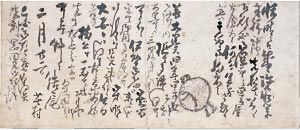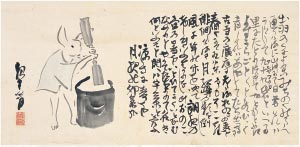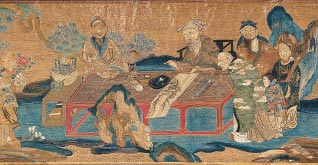

5. Dew on the Summit of Mount Emei
Handscroll, Important Cultural Property
TOREK Collection
Around the mid-eighteenth century, when Buson was active, interest in the poet Bashō (1644–1694) was being revived. This “return to Bashō” eventually became a major literary movement that was widespread in haiku circles. Though Buson did not follow this trend, he too was powerfully inspired and influenced by Bashō.
In the third month of Meiwa 7 (1770), Buson inherited Yahantei (“Midnight Pavilion”), the residence and title of his teacher Sōa in Kyoto and came to work primarily in the old capital. Later, he devoted much effort in paying tribute to Bashō through various activities such as acquainting himself closely to many haiku poets from different traditions, such as Katō Kyōtai (1732–1792) in Nagoya, and producing an illustrated version of Bashō’s travel journal Oku no hosomichi (Narrow Road to the Provinces).

6. Taigi with Equestrian Lantern Carrier
Hanging scroll
Aizu Museum, Waseda University Tomioka Collection
The man holding the inverted umbrella is Taigi. The other figure holding a lantern in his right hand and a partially opened umbrella in his left is Buson. This work gives insight into the close friendship of the two men and their personalities.

7. Letter to Unknown Recipient
Hanging scroll
Publicly exhibited for the first time, this letter by
Buson is his earliest known correspondence. The small
mallet illustrated here as well as the text itself suggest
that Buson’s paintings of Daikoku, the god of wealth,
were very popular at the time.

